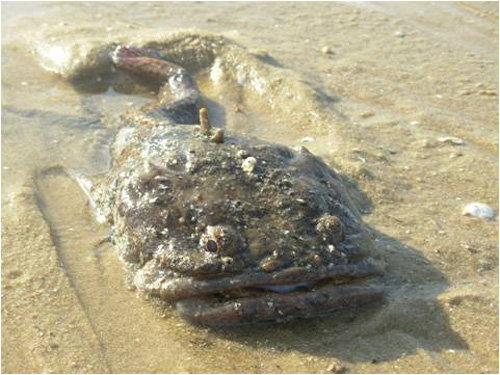M. Clara P. Amorim - amorim@ispa.pt
J. Miguel Simões - jsimoes@ispa.pt
Vitor C. Almada - valmada@ispa.pt
Behavioural Ecology Res. Unit, I.S.P.A.
Rua Jardim do Tabaco 34, 1149-041 Lisbon, Portugal
Paulo J. Fonseca - pjfonseca@fc.ul.pt
Univ. of Lisbon, 1749-016
Lisbon, Portugal
Popular version of paper 1aABa4
Presented Monday morning, May 18, 2009
157th ASA Meeting, Portland, OR
Many fish species are vocal and produce sounds during social behaviour to communicate. Sound production in fishes is especially evident in the breeding season and is typically related to territorial defence and mating activities. We studied the vocal behaviour of the Lusitanian toadfish and have found evidence that their mating sounds show individual differences during short periods of time, which is surprising for fish, but that sounds are modified by environmental factors such as tide level and water temperature, by courtship motivation, and by social interactions. Our study also shows that acoustic signals can also indicate the quality of the calling fish, which is important when resolving a fight or choosing a partner to mate with.

Figure 1. Male toadfish
During the breeding season, Lusitanian toadfish males build a nest under rocks in estuarine shallow waters and emit an advertisement call that sounds like a boat whistle to attract females to mate with. Receptive females deposit the eggs on the roof of the nest and leave the male to defend the nest and take care of the young. Different males nest close together and form singing choruses like frogs or toads.

Figure 2. Toadfish under rock

Figure 3. Female laying eggs
But can a toadfish's mating sounds inform a rival male or a potential mate of its identity, motivation or quality? To study that we recorded for several days groups of males that naturally occupied artificial concrete nests in the intertidal zone. We looked how sound characteristics differed between individuals and whether they changed with environmental and social factors.
Figure 4. Artificial nests
Boat whistles from different males were clearly different and stereotyped in a time frame of few minutes but changed in a longer time scale.

Figure 5. Sound of two males
CLICK TO LISTEN
Water temperature, tide level, fish motivation and the level of social interactions affected most acoustic parameters analysed. For example, during low tide, when the temperature is higher and when it is more difficult for sound to propagate due to the low water depth, there were fewer fish vocalizing, and their sounds were shorter in duration and had lower main frequencies. In contrast, males with a high mating motivation (presenting a high singing rate) produced longer sounds with higher main frequencies than low-motivated individuals, and males in a chorus sang at higher rates than when they vocalised alone. Moreover, males that exhibited higher singing rates or that were capable of a higher contraction rate of the sound-producing muscles when calling (measured by the periodicity of sound pulses) had a better body condition (higher relative body weight and larger fat content). This means that males that can sustain higher singing rates or elevated sonic muscle contraction rates also have more energy reserves to defend the nest and to care for the eggs, and could enjoy higher social status and reproductive success.
Figure 6. Nest with eggs
Figure 7. Clinging young
Our study suggests that at a given time Lusitanian toadfish mating sounds could indicate individual’s identity, motivation and quality but that environmental factors such as tide also modulate the vocal behaviour and sound characteristics of nesting males.